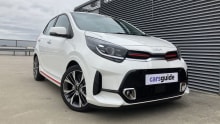
How much does it cost to replace a windscreen?
This used to be a simple question since most car windscreens were made from the...
Browse over 9,000 car reviews
.jpg)
Q: How do hybrid cars charge?
A: When it comes to hybrid vehicles, charging is achieved via a self-charging battery that is used to power an electric motor working in tandem with an internal combustion engine (ICE).
A plug-in hybrid electric vehicle (PHEV), however, must be plugged into an external power source to replenish its rechargeable battery.
If you’ve Googled “hybrid cars meaning” in a perplexed and desperate state, thirsty for some clear information, we’ve got good news for you: what they are is incredibly simple: a car with either a petrol- or diesel-powered ICE that’s couples with a battery-powered electric motor.
As mentioned, the major difference between hybrid vs petrol cars, or even hybrid vs electric cars, is that hybrid technology combines the ICE with an electric motor, which improves the car’s overall efficiency, fuel economy and level of carbon emissions.
In a standard hybrid, the battery-powered electric motor acts as a back-up to provide an extra boost during rapid acceleration, or to conserve ICE (and therefore fuel) usage by kicking in and taking over when the car is idling or travelling at slow speeds.
A PHEV works in much the same way, but because it has a bigger battery than a standard hybrid, it can drive in all-electric mode. Unless, of course, the battery is flat, in which case you’ll be driving using the ICE only (a PHEV is also capable of using both the ICE and electric motor together to deliver the most efficient drive possible).

When it comes to charging hybrid cars, it all depends on what type of hybrid you’re driving - a standard hybrid, or a PHEV.
A standard hybrid is equipped with a self-charging battery, which means you never have to worry about charging it - ever.
This self-charging occurs via a nifty process called 'regenerative braking', which involves harnessing the kinetic energy that is created when a car slows down, and sending it either directly to the electric motor for immediate use, or to the vehicle’s battery pack to be saved up for later on.

Even niftier, the ICE itself can act as a generator while either in motion or idling, thus providing another avenue for the battery to recharge.
If it’s a PHEV we’re talking about, you DO have to recharge it, which should be expected, really, since it has the word 'plug-in' in its name.
While plugging your PHEV into an external power source via a cable may sound like a pain, it’s not, and there’s a major benefit involved: a PHEV has a bigger battery pack than a standard hybrid, which allows it to travel a reasonable distance in all-electric mode (typically 50-60km, although this can be more or less, depending on the size of the vehicle’s battery.

How long a charge actually lasts for depends on a few factors: the size of the battery (the bigger it is, the longer it holds the charge), how you drive the car (the more exuberant you drive, the quicker the battery drains) and at what level your battery was topped up to before you began your journey.
You may hear the terms 'AC' (alternating current) and 'DC' (direct current) thrown about when discussing the electricity used to charge PHEVs and all-electric vehicles, but all you really need to know is this: AC is the kind of electricity you get at home, and it’s slower. DC electricity is a lot faster, and it can only usually be found at a public fast-charging station.
Level 1
This level of AC charging is usually done at home using a domestic wall socket. The output ranges from 2.4 to 3.7kW, which means it’ll take between five to 16 hours to charge a battery from empty to full (keep in mind it’s recommended you should never charge your battery above 80 per cent, as it can lead to battery degradation).
Level 2
Achieved using a domestic or public AC wallbox charger with a typical output of 7.0kW. This lessens charging time to between two to five hours to fully charge a battery from empty.
Level 3
This is where DC fast charging comes in, via a public fast-charger. Outputs are usually between 11-22kW, meaning a battery should get a full charge somewhere in the range of 20 to 60 minutes.
Level 4
This is considered to be super-fast charging, and it’s done at a public DC charging station. Expect an output of around 120kW, which will get the battery fully charged in 20 to 40 minutes.
Ultra-fast charging
This isn’t available to the public in Australia just yet, but when it is, it’ll offer a whopping 350kW of power, which will get your battery charged in around 10 to 15 minutes.










Comments